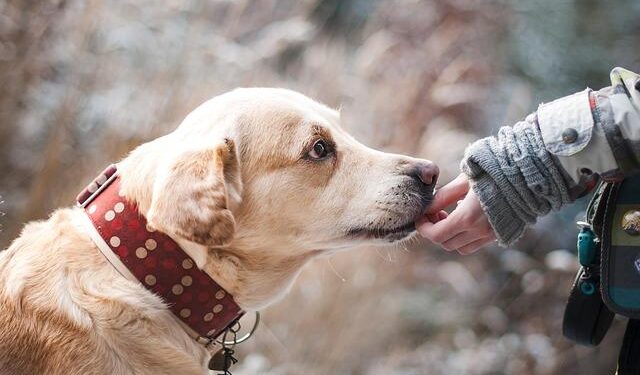Table of Contents
The Silent Language of Stress: Decoding Your Dog’s Inner World
A foundational challenge in addressing canine stress lies in a fundamental communication gap.
While the vast majority of dog owners believe they can accurately interpret their pet’s emotional state, research reveals a significant disparity between this confidence and actual understanding.1
This knowledge gap is not a benign curiosity; it represents a critical barrier to animal welfare.
When the earliest, most subtle signs of distress are missed, stress is allowed to escalate, often culminating in behaviors that appear sudden or “unpredictable” to the uninformed observer.2
Therefore, learning to interpret the full spectrum of canine stress signals is the single most important prerequisite for effective intervention.
All other strategies for stress reduction are rendered less effective, or even useless, if the owner cannot perceive the problem in its nascent stages.
The failure of many stress management plans begins not with a flawed technique, but with a failure of observation.
The Spectrum of Stress Signals
A dog’s communication of stress exists on a continuum, progressing from quiet whispers of discomfort to overt shouts of desperation.
A nuanced understanding requires recognizing not just the signals themselves, but their intensity and, critically, their context.
Subtle Whispers (Displacement & Appeasement Behaviors)
These are the earliest and most frequently overlooked signs of stress.
They often appear as normal behaviors performed in an inappropriate context, representing the dog’s attempt to self-soothe or diffuse a perceived social pressure.4
Key examples include:
- Excessive Yawning: A series of tense, exaggerated yawns when the dog is not tired, such as in a veterinary waiting room, is a classic sign of anxiety.2
- Lip Licking: Quick flicks of the tongue over the nose or lips when no food is present indicate unease.2
- Head Averting: Deliberately turning the head or gaze away from a person, another animal, or an object is an attempt to avoid a confrontation or signal discomfort.2
- Sudden Sniffing or Scratching: An intense, out-of-place focus on sniffing the ground or a brief, frantic scratch can be a way for a dog to distract itself from a stressor.4
Moderate Warnings (Avoidance & Anxiety)
As a dog’s stress level rises, the signals become more pronounced and are often misinterpreted as stubbornness or “bad manners.” These signs indicate the dog is actively anxious and trying to cope with a situation that is becoming overwhelming.
- Body Posture: A hunched or lowered body posture, known as cowering, is a clear sign of fear.2 The tail will often be tucked tightly between the legs.5
- Facial Expressions: The eyes may show a significant portion of the whites, a signal commonly called “whale eye”.5 The pupils may be dilated, and the ears will be pinned back flat against the head.4
- Freezing: A sudden rigidity or stillness in the body indicates the dog is highly stressed and potentially assessing a “fight or flight” response.4
- Escape Behavior: The dog may actively try to hide behind its owner or furniture, or pull on the leash in an attempt to move away from the source of its stress.4
Overt Shouts (Critical Distress)
These are the unmistakable signs that a dog has surpassed its coping threshold.
They are often the first signals that an owner recognizes as a problem, but they represent a state of significant emotional distress.2
- Aggression: Growling, snarling, snapping, or biting are clear communications that the dog feels threatened and needs space. These are often defensive behaviors born from fear.4
- Destructive Behavior: Inappropriate and destructive chewing, digging, or scratching, especially when the owner is absent, is a common manifestation of separation anxiety or extreme stress.9
- Inappropriate Elimination: A house-trained dog that begins urinating or defecating indoors is often communicating severe stress, not a lapse in training.4
- Excessive Vocalization: Persistent, high-pitched barking or whining is a direct vocal expression of discomfort, fear, or anxiety.7
- Physical Signs: Uncontrollable shaking or trembling, restlessness, and an inability to settle or pace incessantly are indicators of critical stress.10
Physiological Manifestations
Stress is not merely a psychological state; it triggers a cascade of physiological changes rooted in the body’s survival mechanisms.
The activation of the sympathetic nervous system initiates the “fight, flight, or freeze” response, flooding the body with stress hormones like adrenaline and cortisol.7
This hormonal surge is responsible for many of the physical signs of stress, including an increased heart rate, panting even when not hot, and excessive drooling.7
This internal turmoil can also lead to significant digestive upset, manifesting as vomiting, increased flatulence, or diarrhea, which may contain blood or mucus in a condition known as stress colitis.7
Appetite is also commonly affected, with some dogs refusing to eat while others may overeat as a coping mechanism.7
Other physical indicators include excessive shedding, drooling beyond what is normal for the breed, and the raising of the hackles (piloerection) along the spine.4
| Signal Category | Signal Name | Description | Stress Level |
| Body Language | Yawning | Tense, exaggerated yawn when not tired 7 | Subtle |
| Lip Licking | Quick tongue flicks over nose/lips without food present 2 | Subtle | |
| Head Averting | Deliberately looking away from a person or stimulus 2 | Subtle | |
| Whale Eye | Whites of the eyes are clearly visible 6 | Moderate | |
| Ears Pinned Back | Ears are held flat against the head 7 | Moderate | |
| Tucked Tail | Tail is held low or between the legs 9 | Moderate | |
| Hiding/Cowering | Body is lowered, attempting to retreat or appear smaller 2 | Moderate | |
| Freezing | Body becomes suddenly rigid and immobile 4 | Moderate | |
| Shaking/Trembling | Involuntary trembling not related to cold 10 | Overt/Critical | |
| Vocalization | Whining/Barking | Excessive, high-pitched, or repetitive vocalization 7 | Overt/Critical |
| Growling/Snapping | Low guttural sound or quick bite attempt 4 | Overt/Critical | |
| Behavioral | Sudden Sniffing | Intense, out-of-context sniffing of the ground 4 | Subtle |
| Destructive Chewing | Chewing furniture, shoes, or other inappropriate items 10 | Overt/Critical | |
| Inappropriate Elimination | Urinating/defecating indoors despite being house-trained 10 | Overt/Critical | |
| Physiological | Panting | Rapid breathing when not hot or having exercised 10 | Moderate |
| Drooling | Excessive salivation beyond breed norm 4 | Moderate | |
| Loss of Appetite | Refusing food or treats 8 | Overt/Critical | |
| Digestive Upset | Diarrhea (stress colitis), vomiting, or flatulence 7 | Overt/Critical |
The Architecture of Anxiety: A Taxonomy of Canine Stressors
To effectively reduce stress, one must first understand its origins.
Canine stressors can be categorized into distinct domains, helping owners to become more effective detectives in identifying what triggers anxiety in their specific dog.
These triggers are not always obvious and can originate from the dog’s external environment, social world, daily routines, and internal state.
Environmental Stressors: The World Outside
A dog’s sensory world is vastly different from a human’s.
With hearing and olfactory senses that are exponentially more powerful, stimuli that are mundane to humans can be overwhelming for dogs.9
- Sensory Overload: Loud, sudden noises are a primary and potent stressor. Fireworks, thunderstorms, vacuum cleaners, and construction noise can induce significant fear and anxiety.9 Similarly, unfamiliar and intense scents, such as the cocktail of pheromones, antiseptics, and fear from other animals in a veterinary clinic, can be highly stressful.9
- Changes in Environment: Dogs are creatures of place and routine. Major changes like moving to a new house, being rehomed, or even significant furniture rearrangement can disrupt their sense of security. This can manifest in stress-related behaviors like inappropriate urination, which is often mistaken for a regression in house-training.2
Social Stressors: The World of Others
The social environment is a complex landscape for dogs, filled with potential triggers related to both familiar and unfamiliar individuals.
- New People and Pets: The introduction of a new person or animal into a dog’s established territory can be a major source of anxiety. This is particularly true for dogs with territorial instincts or those who have had negative social experiences in the past. A slow, patient, and non-forceful introduction is crucial.9
- Household Dynamics: Dogs are highly attuned to the emotional climate of their home. Changes in the family structure—such as the arrival of a new baby, a death in the family, or separation—are profoundly felt. Even the sound of raised voices or arguments between family members can be a significant source of stress.2
- Crowding and Affection: Well-intentioned human behavior can be a source of stress. Being crowded, hugged too tightly, or denied a personal “safe space” to which they can retreat can make a dog feel trapped and anxious.2
- Loss of a Companion: The absence of a bonded companion pet can lead to behaviors indicative of grief and stress.2
Routine-Based Stressors: The Predictability of Life
Predictability creates a sense of safety for dogs; its absence creates anxiety.
- Changes in Routine: Dogs thrive on consistent schedules.9 Abrupt changes to work patterns (such as a return to the office after a period of working from home), feeding times, or exercise schedules can be highly disruptive and are a common cause of separation anxiety and general stress.2
- Inconsistent Rules: Ambiguity is stressful. When a dog is permitted on the furniture one day but reprimanded for the same behavior the next, it creates a state of uncertainty where the dog cannot anticipate its owner’s reaction. This lack of consistent boundaries is a potent, though often overlooked, stressor.2
- Lack of Stimulation: Boredom is a form of chronic, low-grade stress. A lack of adequate physical exercise and, just as importantly, mental stimulation can lead to frustration and the development of problematic behaviors.11
Physiological & Internal Stressors: The World Inside
Not all stressors are external.
A dog’s internal physical state can be a primary driver of anxiety.
- Pain and Illness: Chronic or undiagnosed pain from conditions like arthritis, dental disease, or internal ailments is a major and often invisible source of stress. The behavioral signs of pain and stress can be nearly identical, making a veterinary check-up a critical step in diagnosing any new anxiety-related behavior.2
- Aging: Senior dogs often face a unique set of stressors. Cognitive decline, similar to dementia in humans, can cause confusion, memory loss, and a decreased ability to cope with change, leading to increased anxiety.2
The Human Factor: Emotional Contagion
Perhaps the most profound and underestimated stressor is the emotional state of the dog’s owner.
A dog’s stress level is not an isolated phenomenon; it is deeply intertwined with that of its human companion.
This “emotional contagion” operates through two primary pathways.
First is a physiological synchronization; scientific studies measuring the stress hormone cortisol in hair have demonstrated that long-term stress levels in owners are mirrored in their dogs.5
When an owner is chronically stressed, their dog’s body reflects that stress.
Second is behavioral mirroring.
Dogs are masters of reading human body language and tone of voice.2
An owner’s tension, erratic behavior, or raised voice is immediately perceived by the dog, directly increasing its own stress levels.2
This dynamic means the owner’s emotional state is not simply another item on a list of triggers; it functions as a powerful stress multiplier.
An external stressor, like a thunderstorm, can be significantly amplified if the owner is also anxious.
This creates a destructive feedback loop: the dog reacts to the storm, the owner becomes anxious in response to the dog’s fear, and the dog’s stress then escalates further upon perceiving the owner’s anxiety.
This reframes stress management as a dyadic challenge, elevating owner self-care from a peripheral tip to a core intervention strategy.
The Stress Bucket: A Paradigm for Proactive Management
To move from simply identifying stressors to proactively managing them, a powerful conceptual model is needed.
The “Stress Bucket” is a metaphor that provides an intuitive framework for understanding how stress accumulates in a dog and why seemingly minor events can trigger major reactions.17
This model shifts the owner’s mindset from being a reactive problem-solver to a proactive emotional regulator.
The metaphor consists of three parts:
- The Bucket: This represents a dog’s individual capacity to handle stress. The size of the bucket is unique to each dog, determined by factors like genetics, personality, health, and past experiences. A confident, well-socialized dog might have a large bucket, while a genetically timid or previously traumatized dog may have a very small one.19
- The Water: This symbolizes the cumulative load of stress hormones, like cortisol, in the dog’s system. Every single event that requires the dog to adapt or react—whether positive or negative—adds a drop of “water” to the bucket.18
- The Hole or Tap: This represents the dog’s ability to recover from stress through rest and calming activities. For some dogs, this tap drains slowly, meaning it takes them a long time to return to a calm baseline after a stressful event.18
When water is added to the bucket faster than it can drain, the bucket overflows.
This overflow is what manifests as “problem behaviors” such as lunging, excessive barking, reactivity, or completely shutting down.17
What Fills the Bucket? (Trigger-Stacking in Action)
The crucial insight of the Stress Bucket model is that stress is cumulative.
An overflow is rarely the result of a single, major event but rather the accumulation of many smaller stressors over time—a phenomenon known as “trigger-stacking”.3
A poor night’s sleep, chronic itchiness from allergies, the sight of a cat out the window, a noisy garbage truck, and a tense walk can all add drops to the bucket.
The final trigger—perhaps another dog appearing down the street—may seem minor, but it is the one that causes the overflow.17
Critically, this model reveals that even “positive” or exciting events contribute to the stress load.
A high-arousal, frantic game of fetch, a busy day at doggy daycare, or an exciting agility class all pour water into the bucket because they elevate adrenaline and other stress hormones.17
This directly challenges the overly simplistic mantra that “a tired dog is a good dog,” suggesting instead that an
appropriately stimulated and well-rested dog is a calm dog.
It can take up to 72 hours for stress hormones to fully dissipate from a dog’s system after a significant stressor or a series of smaller ones.
This “72-hour rule” explains why a dog might seem fine after a vet visit on Monday but be unusually reactive on a walk on Wednesday.20
What Does an Overflowing Bucket Look Like?
When a dog’s bucket overflows, its capacity to think rationally and respond to training is severely compromised.17
The resulting behaviors are not a sign of disobedience or a training failure; they are a physiological and emotional response to being overwhelmed.
Common signs of an overflowing bucket include:
- Pulling on the leash
- Barking and lunging at triggers
- An inability to settle or relax in the house
- Jumping up on people
- A lack of focus or disengaging from the owner
- Irritability with other pets or people in the home
- Hiding or avoidance behaviors.17
This model fundamentally reframes the owner’s role from that of a “trainer” to that of a “stress accountant” or “emotional capacity manager.” It explains why isolated training fixes so often fail.
An owner who tries to correct leash-lunging during the walk is only addressing the symptom (the overflow).
This is akin to mopping a flooded floor while the faucet is still gushing.
The true solution lies in managing the dog’s entire emotional economy—proactively monitoring and reducing the inputs into the bucket and intentionally increasing the outputs through decompression—long before the problematic situation is ever encountered.
This perspective illuminates the frustration of owners whose trainers focus only on a single “problem behavior” instead of the dog’s holistic well-being.23
How to Empty the Bucket (Decompression)
Effective stress management involves actively draining the bucket, not just trying to prevent it from filling.
This is achieved through decompression activities that are inherently calming and allow the dog’s nervous system to down-regulate.
- Rest and Downtime: The most powerful tool for emptying the bucket is simply allowing the dog to rest and sleep deeply in a safe, quiet environment.18
- Species-Specific Behaviors: Allowing dogs to engage in natural, calming behaviors is profoundly restorative. This includes:
- Sniffing: Long, meandering “sniffy walks” on a long line in a natural setting allow the dog to process the world through its primary sense, which is incredibly calming.21
- Chewing: The repetitive action of chewing on a safe object, like a filled Kong or a natural chew, releases endorphins and reduces stress.21
- Licking: Licking, often on a textured mat, is a self-soothing behavior that can help calm an anxious dog.
- Mental Stimulation: Low-arousal brain games like food puzzles, snuffle mats, and scent work provide satisfying mental engagement that helps drain the bucket without adding the stress of high excitement.19
A Trauma-Informed Lens: Reframing the “Problem” Dog
While the Stress Bucket explains the mechanics of how stress accumulates, a Trauma-Informed Care (TIC) approach explores the history that shaped the bucket’s size and sensitivity in the first place.
Adapted from human psychology and social care, TIC offers the most advanced and empathetic framework for understanding dogs with extreme, persistent, or seemingly irrational behaviors, particularly those from rescue or abusive backgrounds.25
It represents a profound paradigm shift, moving away from a focus on behavior modification alone and toward an understanding of the animal’s life experience.
The Core Shift: From “What’s Wrong With You?” to “What Happened to You?”
The fundamental principle of TIC is to reframe the question we ask about a struggling animal.
Instead of viewing “problem behaviors” like aggression, hyper-vigilance, or reactivity as inherent flaws in the dog, TIC prompts us to consider them as potential survival adaptations learned in response to past adverse experiences.26
This perspective recognizes that events like abuse, neglect, a chaotic puppyhood, or even a prolonged, stressful stay in a shelter can have significant, lifelong consequences on an animal’s welfare and response to challenges.26
This shift in perspective fosters empathy and patience where there might otherwise be frustration and blame, creating a foundation for true healing.25
The Four “R’s” of Trauma-Informed Care for Dogs
The TIC framework is often summarized by the “Four R’s,” which provide a practical guide for implementation 26:
- Realize the widespread impact of trauma and understand that there are potential paths for recovery. This involves accepting that many dogs, especially those from shelters or with unknown histories, may have experienced trauma.
- Recognize the signs and symptoms of trauma in dogs. These can include an exaggerated startle response, extreme fear of certain stimuli (like raised hands or specific noises), sleep disturbances, hyper-vigilance, and what appears to be self-destructive behavior.26
- Respond by fully integrating knowledge about trauma into all policies, procedures, and practices. This means prioritizing the dog’s sense of safety and emotional well-being above all else.
- Resist Re-traumatization. This is the most critical principle. It means actively seeking to avoid practices and environments that could trigger the dog’s trauma response during assessment, handling, or training. This principle stands in direct opposition to outdated and harmful techniques like “flooding,” where a dog is overwhelmed by a feared stimulus.23
Practical Applications of TIC
Adopting a TIC approach involves tangible changes in how one interacts with and cares for a dog.
- Safety and Predictability: For a traumatized animal, the world can feel chaotic and dangerous. Establishing a highly predictable routine for feeding, walks, and rest provides an essential sense of security. A designated “safe haven,” like a crate or a quiet room, where the dog knows it will never be disturbed, is non-negotiable.28
- Building Trust Through Choice: Trust must be earned at the dog’s pace. This means abandoning the human desire to comfort through touch if the dog’s body language indicates fear. The handler must become an expert observer, listening to what the dog is communicating and allowing the dog to initiate contact. The goal is to give the dog a sense of control over its interactions.27
- The “Five-Second Rule”: For necessary handling that a dog finds stressful (e.g., for medical care), this practical rule can prevent overwhelm. If the dog struggles, the handler proceeds for no more than five seconds before pausing, giving the dog a break, and reassessing. This respects the dog’s communication and builds trust.27
- Redefining Success: In a TIC framework, success is not measured by obedience, but by signs of emotional well-being. A successful outcome is a dog that shows relaxed body language, engages in normal activities like play, and, crucially, is capable of deep, restful sleep.27
The Trauma-Informed Care model provides the ultimate ethical and scientific rationale for why a “one-size-fits-all” approach to dog training is destined to fail, especially for anxious dogs.
It reveals that a dog’s “misbehavior” may not be a conscious choice to be defiant, but a deeply ingrained, involuntary survival response rooted in past trauma.
This understanding completely invalidates any training methodology based on punishment, dominance, or aversive tools.
Applying such methods to a traumatized dog is akin to punishing a person for having a panic attack; it is not only ineffective but is likely to re-traumatize the animal, confirming its belief that the world is a dangerous place and thereby strengthening the very fear that drives the behavior.
TIC provides the definitive foundation for rejecting all aversive practices and fully embracing a methodology built on patience, management, and positive reinforcement.29
The Multi-Modal Toolkit for Cultivating Calm
An effective stress-reduction plan is not about finding a single magic bullet, but about implementing a synergistic, multi-modal strategy.
The tools described below are not isolated tips but interconnected components of a holistic approach.
Their power lies in their combined application, where environmental changes make behavioral work possible, and supplements can lower anxiety enough for a dog to learn.
This integrated system addresses the common pitfall of trying one solution at a time, seeing it fail, and moving on in a scattered and ineffective manner.30
5.1 Environmental Engineering: Creating a Sanctuary
The dog’s immediate environment is the foundation of its well-being.
By engineering a calmer, more predictable world, owners can significantly lower the baseline level of stress in their dog’s bucket.
- The Safe Haven: Every dog, especially an anxious one, requires a designated sanctuary—a crate, a bed in a quiet corner, or a separate room—where it can retreat and feel completely secure. It is essential that this space is respected by all members of the household as a do-not-disturb zone.5
- Routine and Predictability: A consistent daily schedule for feeding, walks, potty breaks, playtime, and bedtime is a powerful anxiolytic. It creates a predictable structure that gives the dog a sense of control and security, reducing the ambient stress of uncertainty.2
- Sensory Management: Modifying the sensory environment can have a profound calming effect.
- Sound: Playing calming classical music, specialized pet-calming audio streams (e.g., iCalmDog), or simply leaving a television or radio on for background noise can help mask startling sounds and soothe an anxious dog.16
- Scent: Aromatherapy using pet-safe essential oils like lavender, chamomile, or vetiver in a diffuser can promote relaxation. Caution must be exercised to ensure the products are safe for canine exposure.33
5.2 Behavioral Modification: Rewiring the Brain
Modern, evidence-based behavior modification for anxiety is built on a foundation of empathy and science.
It is critical to state that aversive methods—including punishment, physical corrections, and tools like prong, choke, or shock collars—are proven to increase fear and stress and are explicitly rejected by veterinary behaviorists and professional training organizations.29
The gold standard is a positive-only approach.
- Counter-Conditioning and Desensitization (CC&D): This two-part process is the most effective technique for changing a dog’s negative emotional response to a specific trigger (e.g., other dogs, strangers, loud noises).
- The Process: The trigger is introduced at a “sub-threshold” distance or intensity—far enough away that the dog notices it but does not yet react with fear. At this safe distance, the trigger is immediately paired with something the dog finds highly rewarding, like high-value food (e.g., chicken, cheese). Over many repetitions, the dog’s emotional association with the trigger changes from “scary thing” to “predictor of good things”.16
- Keys to Success: This process must be executed with extreme patience, always staying below the dog’s reaction threshold. Pushing the dog too fast will backfire and can make the fear worse.23
- Training for Confidence: Regular, short, and fun training sessions for basic commands (sit, stay, come) do more than teach obedience. They establish a clear communication system between owner and dog, build the dog’s confidence in its ability to succeed, and strengthen the human-animal bond.11
5.3 The Holistic Pharmacy: Supplements and Pheromones
A range of non-prescription products can support a behavioral plan by helping to lower a dog’s baseline anxiety.
It is imperative that a veterinarian is consulted before starting any new supplement or medication to ensure safety and proper dosage.
- Pheromones: Products like Adaptil release a synthetic version of the dog-appeasing pheromone, which a mother dog produces to calm her puppies. This can create a general sense of security and is available in diffusers, collars, and sprays, making it useful for managing stress related to environmental changes or separation.16
- Nutritional Support: A high-quality, balanced diet is fundamental to both physical and mental health.12 Omega-3 fatty acids (specifically EPA and DHA), found in fish oil, are particularly noted for their anti-inflammatory properties and support of neurological function, which can help alleviate anxiety.32
- Herbal and Natural Supplements: Several natural compounds have demonstrated calming effects. The table below provides a comparative guide to aid discussion with a veterinarian.
| Supplement Name | Proposed Mechanism | Primary Use Cases | Form(s) | Key Considerations |
| L-Theanine | Amino acid that increases mood-regulating neurotransmitters (serotonin, dopamine) 34 | General anxiety, fear, hyperactivity; promotes relaxation without sedation 32 | Chews, Tablets, Capsules | Generally well-tolerated. Consult vet for dosage. |
| Valerian Root | Increases levels of GABA, a calming neurotransmitter in the brain 34 | Situational anxiety (vet visits, travel), nervousness, excitability 16 | Tincture, Capsules, Tablets | Can have a sedative effect. Do not exceed recommended dosage. |
| Chamomile | Gentle sedative effects; can also soothe an upset stomach 32 | Mild anxiety, travel sickness, nervous stomach 32 | Tea, Tincture, Capsules | Use with caution in dogs with ragweed allergies. |
| CBD Oil | Interacts with the endocannabinoid system to help regulate mood and calm the nervous system 33 | General anxiety, situational stress (fireworks, storms), chronic pain-related stress 33 | Oil/Tincture | Product quality varies greatly. Consult vet for reputable brands and dosage. |
| Melatonin | Hormone that helps regulate the sleep-wake cycle 34 | Noise phobias (thunderstorms), separation anxiety, sleep disturbances 34 | Tablets, Capsules, Sprays | Can cause drowsiness. Consult vet, especially for dogs with medical conditions. |
| Magnesium | Mineral essential for nerve and muscle function; helps regulate stress-response neurotransmitters 34 | Muscle tension, general anxiety, nervousness 34 | Powder, Liquid, Capsules | Dosage is critical; excess can cause digestive upset. Vet consultation is essential. |
5.4 Somatic and Sensory Therapies: Calming the Body
These therapies focus on calming the dog’s physical body to influence its emotional state.
- Canine Massage: Gentle, long, stroking massage can help release muscle tension, lower blood pressure, and calm the nervous system.32
- Compression Wraps: Products like the ThunderShirt apply gentle, constant pressure around the dog’s torso. This pressure has a calming effect on the nervous system, similar to swaddling an infant, and can be effective for situational anxieties like thunderstorms or fireworks.24
- Acupuncture: Performed by a trained veterinary professional, acupuncture involves the insertion of fine needles at specific points on the body to stimulate the release of pain-relieving and mood-elevating endorphins.34
The Human Factor: Your Role as Co-Regulator and Advocate
The final and most crucial element in any canine stress-reduction plan is the human at the other end of the leash.
The data on emotional contagion and the practical realities of managing an anxious dog converge on a single point: the owner’s role transcends that of a simple caregiver.
They must become a co-regulating partner and a staunch advocate for their dog’s well-being.
You Are the Anchor in Their Storm
The scientific evidence is clear: a dog’s emotional state is inextricably linked to its owner’s.5
This principle of co-regulation means that one of the most direct and powerful ways to calm a dog is to remain calm yourself.
When an owner is calm, their steady heart rate, relaxed posture, and even hormonal state provide a biological and behavioral anchor for the dog’s nervous system.
This requires conscious effort, especially in stressful situations.
Practicing mindful body language by crouching down to the dog’s level, speaking in a soft and low tone, and avoiding tense, direct, head-on approaches can actively de-escalate a dog’s fear and anxiety.2
Becoming Your Dog’s Advocate
A primary source of stress for anxious dogs—and a common point of failure for management plans—is unwanted interaction from well-meaning but uninformed people.12
The owner must embrace their role as their dog’s protector and advocate.
This means:
- Setting Boundaries: It is not rude to tell a stranger, “Please don’t pet my dog.” It is responsible.
- Creating Space: It is not anti-social to cross the street to avoid another dog or to leave a family gathering early if it is becoming too overwhelming for the dog.
- The Right to Say No: The owner has the right and the responsibility to refuse any interaction that they know will push their dog over its threshold. This proactive prevention is far more effective than dealing with the fallout of a stressful encounter.23
The Paradox of Exercise
Standard advice often defaults to “more exercise,” but this can be counterproductive for an anxious dog.30
As the Stress Bucket model illustrates, high-arousal, repetitive activities like frantic ball chasing or running through a trigger-filled urban environment can actually elevate stress hormones and fill the bucket faster.21
The focus must shift from the
quantity of exercise to its quality.
For an anxious dog, a 30-minute calm, “sniffy” decompression walk in a quiet park is far more beneficial for emptying the stress bucket than a one-hour, high-stress jog on busy sidewalks.21
Ultimately, the human’s role evolves into that of an “external executive function.” A dog in a state of high stress or fear is physiologically incapable of rational thought; its “fight or flight” system is in control.7
The human, with a capacity for foresight and planning, can assess a situation, recognize potential triggers, and make a logical decision to prevent a negative outcome—in essence, lending their prefrontal cortex to the dog.
This is not merely managing a pet; it is an act of profound partnership and co-regulation, the deepest expression of responsible stewardship.
Conclusion: From Management to Mastery—Forging a Resilient Bond
The journey to alleviating stress in a canine companion is a transformative one, not just for the dog, but for the human as well.
It begins with a commitment to learning a new language—the subtle, silent language of canine body posture and behavior.
It requires becoming a detective, architect, and accountant of the dog’s emotional world, understanding the triggers that fill their Stress Bucket and the calming activities that drain it.
It calls for a profound shift in perspective, especially for dogs with challenging pasts, moving from a lens of frustration to one of Trauma-Informed empathy, asking not “what is wrong with you?” but “what happened to you?”
The path forward is not paved with a single solution, but is built through the synergistic application of a multi-modal toolkit: engineering a safe environment, employing patient and positive behavioral modification, utilizing supportive supplements and therapies, and, above all, embracing the human’s role as a calm anchor and unwavering advocate.
This process moves beyond simply managing “problem behaviors.” It is a journey toward mastery of a deeply empathetic and skillful partnership.
By understanding and addressing the root causes of stress, owners can do more than just reduce anxiety; they can foster resilience, build unshakeable trust, and forge a bond of unparalleled depth.
The ultimate goal is not just a less-stressed dog, but a truly happy one—a dog with soft eyes, a relaxed and wiggly body, a healthy appetite for food and for life, and the quiet confidence that comes from knowing it is safe, understood, and unconditionally supported.35
Works cited
- Most dog owners can’t read stress signals, findings show – Vet Times, accessed on August 9, 2025, https://www.vettimes.com/news/vets/small-animal-vets/most-dog-owners-cant-read-stress-signals-findings-show
- How to spot signs of stress in dogs – Petplan, accessed on August 9, 2025, https://www.petplan.co.uk/dog-insurance/dog-care-and-advice/stress-in-dogs.html
- Recognizing and Mitigating Canine Stress during Animal Assisted …, accessed on August 9, 2025, https://pmc.ncbi.nlm.nih.gov/articles/PMC8623698/
- Is Your Pet Stressed? Common Signs and How to Manage Anxiety – CareCredit, accessed on August 9, 2025, https://www.carecredit.com/well-u/pet-care/dog-cat-stressed-how-to-tell-what-to-do/
- A Pet Owner’s Guide: The Surprising Link Between Your Stress and Your Dog’s Health, accessed on August 9, 2025, https://www.mvsu.edu/sites/default/files/webform/a-pet-owner-s-guide-the-surprising-link-between-your-stress-and-your-dog-s-health-vmqstm.html
- www.akc.org, accessed on August 9, 2025, https://www.akc.org/expert-advice/training/how-to-tell-if-your-dog-is-stressed/#:~:text=Stress%20signs%20to%20look%20for,eye%20contact%20or%20look%20away.
- Signs of Stress in Dogs: 12 Body Language Signs & Symptoms – Pupford, accessed on August 9, 2025, https://pupford.com/blogs/all/stress-signals-dogs
- How to Recognize and Ease Stress in Dogs – Hill’s Pet Nutrition, accessed on August 9, 2025, https://www.hillspet.com/dog-care/behavior-appearance/recognizing-and-easing-stress-in-dogs
- 10 Things That Stress Dogs Out (Vet Approved) – Dogster, accessed on August 9, 2025, https://www.dogster.com/dog-health-care/things-that-stress-dogs-out
- Critical Signs of Stress in Dogs – Vitalize Canine, accessed on August 9, 2025, https://vitalizek9.com/2024/04/29/critical-signs-of-stress-in-dogs/
- Stress in Dogs: Vet-Reviewed Causes, Signs & How to Help – Dogster, accessed on August 9, 2025, https://www.dogster.com/dog-training/stressed-dog
- Stress in Dogs: Causes, Symptoms & Finding Relief – Hill’s Pet Nutrition, accessed on August 9, 2025, https://www.hillspet.com/dog-care/behavior-appearance/dog-stress
- 12 Critical and Non-Critical Signs of Stress in Dogs and How to Help – Charlotte’s Web, accessed on August 9, 2025, https://www.charlottesweb.com/blogs/learn/12-critical-and-non-critical-signs-of-stress-in-dogs-and-how-to-help
- www.bluecross.org.uk, accessed on August 9, 2025, https://www.bluecross.org.uk/advice/dog/behaviour-and-training/stress-in-dogs#:~:text=It’s%20normal%20for%20your%20dog,by%20a%20change%20in%20routine.
- Stress in dogs – Blue Cross, accessed on August 9, 2025, https://www.bluecross.org.uk/advice/dog/behaviour-and-training/stress-in-dogs
- 7 Ways to Calm your Anxious Dog – Vet Pharmacy, accessed on August 9, 2025, https://www.vetpharmacy.co.uk/blog/dog-stress-relief/
- Massively Improve your Dog’s Behaviour, Lifespan and Health – Absolute Dogs, accessed on August 9, 2025, https://absolute-dogs.com/blogs/gamechangers/massively-improve-your-dogs-behaviour-lifespan-and-health-without-pharmaceuticals
- Your dog’s bucket and how it affects training – Sussex Canines, accessed on August 9, 2025, https://www.sussexcanines.co.uk/blog/your-dogs-bucket
- Understanding the Canine Emotional Bucket: Managing Stress for a Happier Dog, accessed on August 9, 2025, https://www.thetrainingofdogs.com/post/understanding-the-canine-emotional-bucket-managing-stress-for-a-happier-dog
- How to help your reactive dog part 1 – Doherty Dog Services, accessed on August 9, 2025, https://dohertydogservices.com/reactive-dog-part-1/
- Stress Bucket – Positive Dog Training, accessed on August 9, 2025, https://positive.dog/stress-bucket/
- How Long Should I Walk My dog For Each Day? – Absolute Dogs, accessed on August 9, 2025, https://absolute-dogs.com/blogs/gamechangers/the-number-one-dog-ownership-myth-that-might-be-harming-your-dog
- Fearful Aggression Issues – Positively | Victoria Stilwell | Forum, accessed on August 9, 2025, https://forum.positively.com/viewtopic.php?t=8941
- Top 10 Tips for Relieving Your Pet’s Stress – Vet in Fairfax California, accessed on August 9, 2025, https://fairfaxvet.com/top-10-tips-for-relieving-your-pets-stress/
- (PDF) Potential Benefits of a ‘Trauma-Informed Care’ Approach to Improve the Assessment and Management of Dogs Presented with Anxiety Disorders – ResearchGate, accessed on August 9, 2025, https://www.researchgate.net/publication/377860769_Potential_Benefits_of_a_’Trauma-Informed_Care’_Approach_to_Improve_the_Assessment_and_Management_of_Dogs_Presented_with_Anxiety_Disorders
- Potential Benefits of a ‘Trauma-Informed Care’ Approach, accessed on August 9, 2025, https://pmc.ncbi.nlm.nih.gov/articles/PMC10854685/
- Ask the expert: Treating trauma | HumanePro by Humane World for Animals, accessed on August 9, 2025, https://humanepro.org/magazine/articles/ask-expert-treating-trauma
- From trauma to trust | Humane World for Animals, accessed on August 9, 2025, https://www.humaneworld.org/en/all-animals/trauma-trust
- Veterinary behaviorists: No role for aversive dog training practices, accessed on August 9, 2025, https://www.avma.org/javma-news/2021-11-01/veterinary-behaviorists-no-role-aversive-dog-training-practices
- feeling completely overwhelmed and like a total failure to my dog : r/Dogtraining – Reddit, accessed on August 9, 2025, https://www.reddit.com/r/Dogtraining/comments/r1ysjz/feeling_completely_overwhelmed_and_like_a_total/
- Please help – my dog is having behavioral problems so bad, my trainer doesn’t even know what to do. : r/Dogtraining – Reddit, accessed on August 9, 2025, https://www.reddit.com/r/Dogtraining/comments/ywlv34/please_help_my_dog_is_having_behavioral_problems/
- Canine Stress Management: Holistic Approaches – Chill Paws, accessed on August 9, 2025, https://www.chillpaws.com/blogs/news/canine-stress-management-holistic-approaches
- How To Calm Dog Anxiety Naturally, accessed on August 9, 2025, https://www.dogsnaturallymagazine.com/6-natural-solutions-for-dog-anxiety/
- Holistic Approaches to Relieving Stress and Anxiety in Dogs: Herbs and – StreamZ Global, accessed on August 9, 2025, https://us.streamz-global.com/blogs/articles/holistic-approaches-to-relieving-stress-and-anxiety-in-dogs-herbs-and-natural-supplements
- 10 signs that show your dog is truly happy (and likely healthy), accessed on August 9, 2025, https://timesofindia.indiatimes.com/life-style/relationships/pets/10-signs-that-show-your-dog-is-truly-happy-and-likely-healthy/articleshow/123049704.cms






